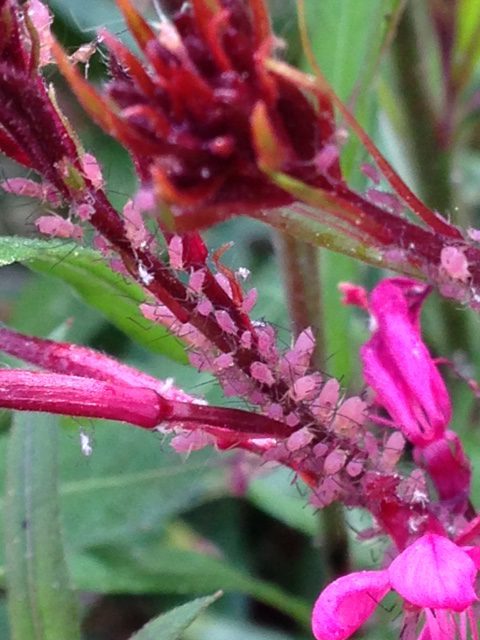
by Julie McConnell | May 5, 2016
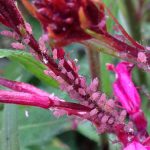
Aphids (Macrosiphum gaurae) feeding on gaura. Photo: Julie McConnell, UF/IFAS
Every day, if I get home before the sun goes down, I like to walk around my garden and see how things are growing. At this time of year there are always new surprises in the garden – plants leafing out after a winter break, new flower buds and blooms, and of course sometimes garden pests.
My daughter and I collected some flowers last weekend and after they sat on the table for a few minutes I noticed pink bugs crawling around on the gaura stems. On further inspection I realized the stem was covered in aphids which made me go out to look at the entire plant. I found a prolific population
of aphids on the gaura and also lady beetle larvae hunting and eating the aphids! Instead of mixing up a bottle of insecticidal soap I decided to let the lady beetles do their job and just monitor the situation.
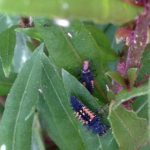
Multicolored Asian Lady Beetle Larvae feeding on aphids. Photo: Julie McConnell, UF/IFAS
Five days later I went to show my example of natural biological control to a visiting friend and we could not find a single aphid on my plant. This may not be the typical response, usually I see some level of both predator and prey but in this instance the lady beetle did a fantastic job of controlling the aphids.
So, did they eat every last one? Probably not, they likely ate many of them and the others left the plant because the predator pressure was too great. However, either scenario saved my plant from severe damage which was the overall goal.
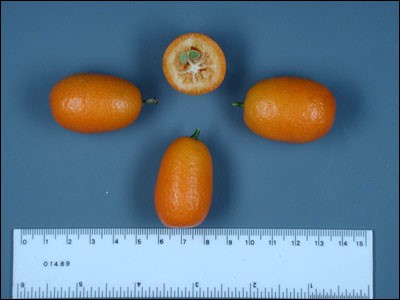
by Mary Salinas | May 5, 2016
The panhandle of Florida is a great place to grow citrus with our plentiful sunshine and sandy soil. But some varieties do better than others. Here are some that thrive in the more northerly climes of Florida:
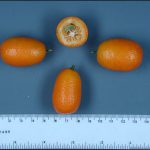
Nagami kumquat. Photo credit: UF/IFAS.
- Satsuma mandarin is cold hardy to 15°F once established. There are a few different available cultivars with fruit ripening October through December. Fruit needs to be picked promptly when ripe.
- Kumquat is cold hardy to 10°F once established. ‘Nagami’ and ‘Meiwa’ are the two common cultivars of the small tart fruits. Fruit matures in fall and winter and holds fairly well on the trees.
- Calamondin is a lesser known variety that bears small fruit that resemble tangerines. The tart fruit is great for jams and chutneys. Fruit is borne all year.
- Some of the sweet oranges that do well in the panhandle are Navel, Hamlin and Parson Brown. They are cold hardy to 14°F once established and are harvested November through January.
- Minneola or Honeybell tangelo is also hardy to 14°F and harvested in January. This is a cross between a Duncan grapefruit and a Darcy tangerine. This bell-shaped fruit is very juicy and sweet. Unlike the other citrus varieties, it needs another citrus nearby for cross-pollination in order to produce an abundant crop.
- Meyer Lemon is the choice to make if you would like to grow lemons in the panhandle. Other lemons may be damaged by our occasional freezes.
Grapefruit and lime can be grown – although unreliably – on the coast with protection from northwestern winter winds. They are much more susceptible to freezes in more northerly panhandle locations.
In order to have the healthiest and most productive trees, learn about how to properly care for citrus and how to recognize and combat the pests and diseases that occur.
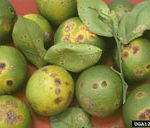
Citrus canker symptoms on leaves, fruit and stem. Photo by Timothy Schubert, FDACS
There are threats to our dooryard and commercial citrus from pests and disease. Only vigilance will help to combat the challenges so that we may continue to grow and enjoy our citrus. What can we do to protect our citrus?
- Report any serious diseases like suspected citrus canker or citrus greening to the Division of Plant Industry by calling toll-free 1-888-397-1517. Inspections and diagnosis are free. Citrus canker has been confirmed in south Santa Rosa County in the past 3 years.
- Purchase citrus trees only from registered nurseries – they may cost a little more but they have gone through an extensive process to remain disease and pest free. That will save you $$ in the long run!
- Don’t bring plants or fruit back into Florida – they may be harboring a pest!
- Citrus trees or fruit cannot move in or out of the State of Florida without a permit. This applies to homeowners as well as to the industry. This rule protects our vital dooryard trees and citrus industry.
For more information please see:
Save Our Citrus Website
UF IFAS Gardening Solutions: Citrus
Citrus Culture in the Home Landscape
UF IFAS Extension Online Guide to Citrus Diseases
Your Florida Dooryard Citrus Guide – Common Pests, Disease and Disorders of Dooryard Citrus
by Beth Bolles | May 5, 2016
Believe it or not, there is a beneficial ant that is found in many landscapes. If you see an interesting mound shaped like a small volcano, you likely have the pyramid ants. These ants form small nests in sandy soils and the mound will have a small opening in the very center.
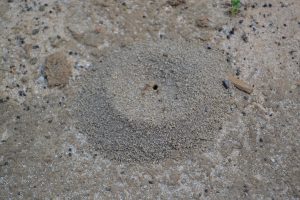
Pyramid ant mound, about 5 inches across. Photo by Beth Bolles
Pyramid ants are not aggressive and do not sting. They are fast moving over the ground building the mound and searching for food. Ants will collect honeydew from other insects and the beneficial part is that ants hunt live insects including winged fire ants. By allowing the pyramid ants to remain in parts of your landscape, you may reduce the numbers of fire ants that can establish in that area.
When you see the distinctive pyramid ant mounds, remember the beneficial role they play in keeping pest species in check. Keep any baits away from these areas to protect the pyramid ants.
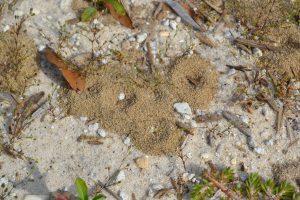
A group of small mounds. Photo by Beth Bolles








